
I’ve just posted my review of the Canon PowerShot SD780 IS Digital ELPH aka Digital IXUS 100 IS, an ultra-compact camera with a lot of resolution and a HD 720p movie mode. Check out the Canon SD780 Digital ELPH/Digital IXUS 100 IS photo gallery for sample photos as well. Hit the link for the full review of the camera.
DPInterface Canon PowerShot SD780 IS Digital ELPH/Digital IXUS 100 IS Review
Brad Soo – April 30th, 2009
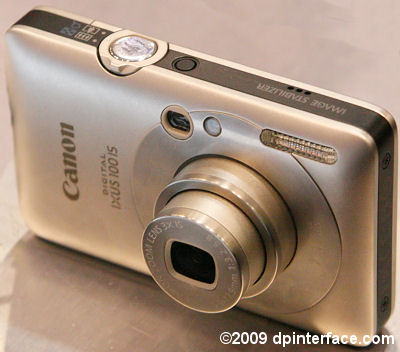
One of the latest ultra-compacts announced by Canon in 2009 is the SD780 IS Digital ELPH. The SD1200 and SD780 are almost twins; with the latter being the higher end model of the two. To give you a rundown of the SD780 IS Digital ELPH’s features; it has 12 megapixels, a 3X zoom lens which goes a tad wider than the one on the SD1200, 2.5 inch LCD with an optical viewfinder as well as a high-definition 720p movie mode. Did I mention the camera has Canon’s latest DIGIC 4 processor, bells & whistles and also comes in your choice of four (wild) colors?
As with all the Digital ELPHs of the past, this one has three (!!) names. It’s known as the Canon PowerShot SD780 IS Digital ELPH in the US while in places around the world, like Europe and Asia, it’s called the Canon Digital IXUS 100 IS. And in Japan, the same camera sells under the IXY DIGITAL name.

Whew, with that out of the way, let’s have a more in-depth look at this trendy little camera now.
Size and Weight
(159.9) 87.0 x 54.5 x 18.4 mm (115 g) - Canon PowerShot SD780 IS Digital ELPH
(172.8) 97.1 x 59.4 x 16.3 mm (121 g) – Casio Exilim FS10
(175.2) 90.5 x 59.0 x 25.7 mm (117 g) - Fujifilm FinePix Z30
(166.0) 90.0 x 53.0 x 23.0 mm (120 g) – Nikon Coolpix S620
(173.1) 97.0 x 54.4 x 21.7 mm (117 g) - Panasonic Lumix FS7
(176.7) 97.0 x 57.9 x 21.8 mm (126 g) - Panasonic Lumix FS25
(172.5) 97.0 x 54.0 x 21.5 mm (110 g) – Pentax Optio P70
(167.7) 94.0 x 55.9 x 17.8 mm (121 g) – Samsung TL100
(165.8) 93.6 x 57.2 x 15.0 mm (128 g) - Sony Cyber-shot T90
(172.0) 97.9 x 57.8 x 16.3 mm (124 g) - Sony Cyber-shot T900
All the weight figures above show when the camera is empty without a battery or memory card
The Canon PowerShot SD780 IS Digital ELPH is the smallest, and one of the lightest, ultra-compact cameras in its class and you’ll appreciate its tiny size (buttons are decently sized too). Just a little note, all of the cameras above are pocketable, and I’d be worried for the size of the buttons on the back if the SD780 got any smaller.
Box packaging
The Canon PowerShot SD780 IS Digital ELPH has your average digital camera box contents – no surprises here:
- Rechargeable lithium-ion battery (NB-4L)
- Battery charger
- Wrist strap
- USB and A/V cables
- Camera software CD
- User’s manual
Lucky for you and the environment, Canon doesn’t include any memory card with the SD780 Digital ELPH (usually they have a sense of humor and give you a useless 16 or 32 MB card). And as expected, you’ll have to get your own (which would be the case anyway, even if Canon had included one of the ridiculously tiny cards) and the SD780 takes SD/SDHC memory cards.
I would recommend at least a 2 GB SD to begin with; or a 4 GB SDHC if you’re planning to record high-definition movies. A high-speed memory card definitely helps in boosting performance so you may want to consider getting a high-speed version of your SD/SDHC (anything from 60X to 80X speed would be good).
210 shots - Canon PowerShot SD780 IS Digital ELPH
200 shots - Fujifilm FinePix Z30
250 shots – Nikon Coolpix S620
360 shots - Panasonic Lumix FS7
330 shots - Panasonic Lumix FS25
200 shots – Pentax Optio P70
200 shots – Samsung TL100
220 shots – Sony Cyber-shot T90
200 shots - Sony Cyber-shot T900
All the cameras above are rated with rechargeable batteries according to CIPA Standard
The Canon PowerShot SD780 IS Digital ELPH uses the same NB-4L rechargeable lithium-ion battery that many of the ultra-compact Digital ELPHs have been using for the past few years. Unlike its predecessor, the SD770 of 2008, the SD780 Digital ELPH here gets just average battery life numbers compared to the competition. The camera is rated to 210 shots per charge (CIPA Standard) with the LCD on, which is on par on most ultra-compacts but there are a few which outperform the rest by a far margin (look at the two Lumix models). However, you can turn the LCD off and use the camera’s optical viewfinder, which will extend battery life greatly.
Accessories
In terms of accessories, the Canon SD780 IS Digital ELPH offers an AC adapter, a slave flash, waterproof case and various camera cases. Obviously you won’t find any conversion lens or filter accessories for this ultra-compact.
Camera Tour
The Canon PowerShot SD780 Digital ELPH aka Digital IXUS 100 is a stylish little ultra-compact. There camera looks a lot like other Digital ELPHs, especially its predecessor, except the SD780 over here shaves off sharp edges from its design (even the flash edges are rounded) so the camera doesn’t look too boxy.
Build quality (Except the compartment door) and ergonomics are both decent; the SD780 IS Digital ELPH feels sturdy in hand and can be operated with one or both hands. The size of the buttons may look small but they’re still easy to press with your thumb. The only thing I’m not a fan of is the round and small mode switch – most of the time, you’ll need to use your nail operate it.
The Canon PowerShot SD780 IS Digital ELPH aka Digital IXUS 100 IS comes in your choice of four trendy colors: silver, gold, a nicely-toned black and an over-the-top red (it almost hurts your eyes when you look at the red SD780 for too long).
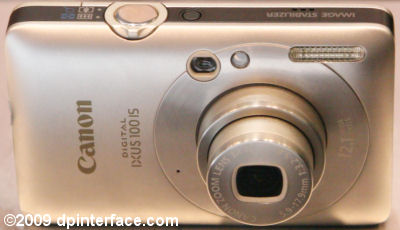
There’s a new zoom lens on the SD780 Digital ELPH… it still has 3X optical zoom but it goes a little wider than the 35-105 mm lens that has become the staple of many Digital ELPHs. Over here, the lens is equivalent to 33 – 100 mm (vs 35-105 mm). Unfortunately with this new lens, the aperture range has gone down the hill to a slow f3.2 – f5.8 (versus f2.8-4.9 of the other lens). Personally, I would rather have Canon stick to the old lens; the sacrifice in lens speed is just not worth the added 6% of wide-angle coverage. As usual, there’s optical image stabilization in the lens; almost a crucial feature in compact cameras, which helps reduce blur caused by camera shake.
The SD780 Digital ELPH’s flash is a tad underpowered compared to other ultra-compact cameras nowadays. At wide-angle (Auto ISO), the flash covers 30 cm to 3.5 m, and that range goes down to 45 cm to 2.0 m at telephoto. Above the lens are two circles: the optical viewfinder window on the left and the autofocus assist/self-timer lamp on the right. You’ll also see a hole in the middle of nowhere on the front of the SD780 IS – that’s the microphone for recording sound.
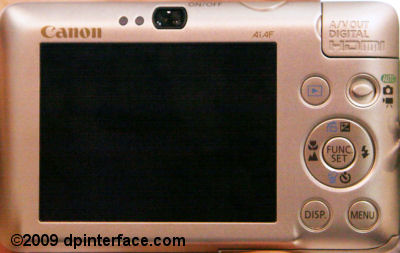
The Canon PowerShot SD780 IS Digital ELPH aka Digital IXUS 100 IS offers you two ways of composing your pictures. The first thing is via the LCD, as usual… the one here measures 2.5 inches and is sharp with 230,000 pixels. Indoor visibility is good and so is outdoor visibility thanks to Canon’s PureColor II combo of coatings on the LCD.
You can also use the old-school way of using the optical viewfinder, which is situated directly above the LCD display. The viewfinder is small, not even close to the ones found on digital SLRs, but it’s still useful in cases where you’d want to steady the camera to your eye, be stealthy or if LCDs are just not your thing. There are also two status indicator lights directly next to the optical viewfinder, which tell you about the camera’s focus status, processing activities and flash charge status.
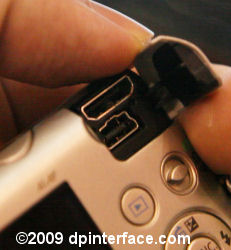
To the right of the LCD screen are a row of controls for the camera. The area at the very top, where your thumb will rest, is actually the cover over the SD780’s connectivity ports. Under it are the camera’s single mini-B jack used for both USB and A/V Out connectivity. There’s also a mini HDMI port for hooking up the SD780 Digital ELPH with your high-definition television.
Below that, there’s the camera’s playback button and quirky mode switch I was talking about. I think Canon wanted a “rounded†design for the SD780, so that might explain why the mode switch looks just like a button. It moves you between smart auto, normal shooting/scene and movie modes. Smart Auto is a feature new to Canon cameras – it detects the scene you’re shooting and automatically chooses an appropriate scene mode and handles all camera settings (basically being more automatic a shooting mode than ever).
Next up is the SD780’s five way navigation pad… Wait a minute… hey, I just noticed the lovable Canon print button is gone! Not to worry, you can still handle print marking and printing from the camera’s playback menu but you won’t have a dedicated shortcut button any more. On to the navigation pad:
- Up – Exposure compensation (+/-2 EV in 1/3 steps)/Playback jump
- Down – Self-timer (Off, face self-timer, normal self-timer)
- Left - Focus mode (Normal, macro, landscape)
- Right - Flash setting (Auto, on, slow sync, off; red-eye reduction is turned on/off in the menu)
- Center – Function menu/Set
The Canon PowerShot SD780 IS Digital ELPH aka Digital IXUS 100 IS has a Face Self-timer mode, which works in conjunction with the camera’s face detection technology. The camera will watch the scene until an ‘extra face’ is detected, before starting the countdown to take picture/pictures.
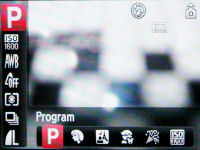
Pressing the center button brings up the camera’s function menu which contains several settings that can be changed:
- Sub-shooting mode (Program, portrait, night scene, kids & pets, indoor, other scene modes)
- ISO (Auto, Auto high, 80, 100, 200, 400, 800, 1600)
- White balance (Auto, daylight, cloudy, tungsten, fluorescent, fluorescent H, custom)
- My Colors (Normal, vivid, vivid [blue/green/red], neutral, sepia, black & white, positive film, lighter/darker skin tone, custom)
- Metering method (Evaluative, center-weighted, spot)
- Drive mode (Single-shot, continuous shooting)
- Image size and compression
The custom option in the My Colors/Photo Effects area enables you to manually tweak contrast, saturation, sharpness and individual red, green, blue and skin tone levels; all up to +/- 2 in 1 step increments)
Lastly, we have the DISPlay and MENU buttons. The former toggles the information being displayed on-screen while the latter brings up the camera menu.

There are just three things on the top of the Canon PowerShot SD780 IS Digital ELPH. First is the microphone (under the words “Image Stabilizerâ€). Over towards the right is the power button and shutter button with a wrapped around zoom controller.
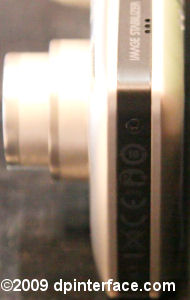
On this side of the camera, you can admire how thin the SD780 is and on the other side is the wrist strap loop.

Let’s look at the bottom of the Canon PowerShot SD780 IS Digital ELPH now. There’s a tripod mount and the battery/memory card compartment. The compartment door doesn’t feel as solid as the rest of the camera though.
Taking pictures (Shooting mode)
On the LCD screen of the Canon PowerShot SD780 IS Digital ELPH, you’re able to view exposure information, camera settings and a simple battery indicator. There isn’t any live histogram available however.
The 12 megapixel SD780 IS Digital ELPH allows you to choose from multiple image sizes and compression modes to suit your needs. You can choose to use full 12 MP, 8 MP, 5 MP, 2 MP, VGA and widescreen. There are also two image compression modes here: Fine and Standard… and a 2 GB card will hold about 625 Fine, full-resolution photos.
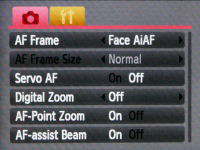
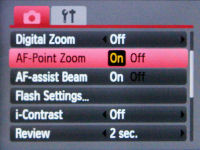
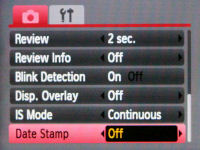
Most of the camera’s main settings can be adjusted via the Function menu I described in the previous section, but now let’s head on to the other settings in the camera’s main menu:
- Autofocus mode (Face detection, 9 point AF, center AF)
- AF point size (Normal, small) – Choose how size of the camera’s focusing point area
- Servo AF – Turning this on will make the camera focus continuously; turn it off and the camera only auto focuses when you half-press the shutter button
- Digital zoom – you should keep this turned off, it lowers picture quality
- AF point zoom – magnify the area the camera focuses on
- AF assist beam – to help the camera focus in low-light
- Flash settings – turn red-eye reduction and slow sync
- iContrast – see below
- Review – This option decides whether the camera will show the image on the LCD screen right after the picture is taken
- Review info
- Blink detection – whether the camera checks for any ‘blinks’ in your photo and alert you about them
- Display overlay
- IS (Image stabilization) Mode – Off, Continuous, Shoot-only, Panning
- Date stamp (Off, date, date and time)
Servo AF is a new feature to the Digital ELPH line which allows the camera to continuously track and focus on subjects; thus reducing the time for the camera to focus and take the picture itself.
The Canon PowerShot SD780 IS Digital ELPH has a new iContrast feature which Canon introduced to their most recent cameras this fall. iContrast is a fancy name for a feature which attempts to brighten up dark areas in your photos (something like D-Lighting, Shadow Adjustment, etc you see on other cameras) – and there are four levels you can select from (Off, auto, low, medium, high). iContrast works but the difference it makes is subtle and not extreme.
There’s only one Digital ELPH at the moment which features full manual exposure controls but the Canon SD780 IS is not it. Instead, you’ll find a lot of scene modes on the camera, including: portrait, foliage, snow, beach, sunset, fireworks, aquarium, underwater, ISO 3200, indoor, kids & pets, night snapshot, color accent, color swap, long shutter and stitch assist.
Probably the only manual control besides white balance that you’ll find on the SD780 would be long exposure; and that has been moved over here and classified as the “Long Shutter†scene mode. In this mode, you can manually select a long shutter speed between 1 to 15 seconds to take low-light/night shots.
The SD780 IS Digital ELPH has a good macro mode with a minimum focusing distance of 3 cm at wide-angle. You can also select Digital Macro, which allows you to utilize the camera’s 4X digital zoom to close in further on your subject (but this will also reduce picture quality).
The SD780 Digital ELPH has face detection and also blink detection (the latter is a new feature). The camera is able to lock onto faces pretty accurately, just like all the other Canon cameras I reviewed in the past. Blink detection works in-conjunction with face detection, will automatically look for any “blinks†in faces once a photo is taken and then alert you on the screen (with an icon which looks like this >.< and I’m not kidding) that you should retake the shot. Well, while it isn’t something I would be helpless without; blink detection is still pretty handy, especially if you’re the type who takes a lot of people photos. There’s also automatic redeye removal, which I’ll talk about in the image quality section later on in the review.
Video Recording
Canon recently started implementing High-Definition movie modes in some of their 2009 cameras; and the Canon PowerShot SD780 IS Digital ELPH is one of them. You can record 720p (1280 x 720) video clips with sound at 30 FPS… and the brilliant change here is that movies now use the H.264 (in MOV) recording codec. So file sizes won’t be as huge as when previous cameras were using the AVI MJPEG format. A 4 GB memory card will hold about 22 minutes worth of HD video.
Of course, if HD isn’t your thing, you can opt to lower resolution to VGA (640 X 480) or QVGA (320 X 240) to extend recording time greatly. At both of those resolutions, videos are still recorded at 30 FPS with sound. There’s a limit of up to 4 GB or 30 minutes (HD video)/60 minutes (for VGA/QVGA) per movie clip, whichever comes first – unless you’re planning on recording a play onto a single huge movie file, I doubt that this “4 GB per clip limit†would be an issue for many people.
You are able to use the color accent and color swap features I mentioned above as well as change most of the settings in the function menu before recording a movie. Exposure is automatically adjusted, plus you can use both optical image stabilization and up to 4X digital zoom while recording a movie clip. You cannot use optical zoom, however.
The SD780 Digital ELPH produced very good video quality with average sound. It was nice of Canon to finally include a HD movie mode with a handful of their cameras and the SD780 can double as – but maybe not substitute – a video recording device when needed (though you can’t use optical zoom while recording).
Performance
All performance testing of the Canon PowerShot SD780 IS Digital ELPH was performed using a high-speed 4 GB SanDisk Ultra II SDHC (90X) card.
Now let’s check out the performance of the Canon PowerShot SD780 IS Digital ELPH aka Digital IXUS 100 IS… The camera has a quick one second startup time and performs well in the focusing department as well. Autofocus in good light typically takes 0.2 to 0.3 seconds; a little longer in low-light (the SD780 still managed to lock focus though).
- Shot-to-shot speed - 1 shot every 1.7 seconds, above average
- Flash recharge time using a fully charged battery - 3 seconds on average
The SD780 IS Digital ELPH’s continuous shooting isn’t anything to shout about. The camera is able to shoot continuously at rather leisurely 0.9 frames per second until the memory card fills up. You could probably increase shooting speed very slightly (up to about 1 frame per second) by using the viewfinder but nothing significant here. Sigh, it seems just about ALL 12 megapixel compacts in the market these days have paltry continuous shooting frame rates thanks to their high resolution.
The SD780’s optical zoom lens moves quite quickly from wide-angle to telephoto in just one second. There are just seven steps in between the zoom range though and the motor sound is audible (the reason why you can’t use optical zoom while recording a movie). Shut down time took 2 seconds with the lens at telephoto.
The Canon PowerShot SD780 IS Digital ELPH displayed good performance overall. I couldn’t help but feel the camera could have performed a lot faster in continuous shooting mode though. It’s mostly the 12 megapixels of resolution which bogs down the camera as previous 10 megapixel cameras could shoot around the 1.4-1.6 FPS range in burst mode.
Image Quality
Now, let’s have a look at the Canon PowerShot SD780 IS Digital ELPH aka Digital IXUS 100’s image quality characteristics:







Using the first two ISO settings (ISO 80 and ISO 100), the PowerShot SD780 IS Digital ELPH produces clean photos. Go up to ISO 200 and we see a few extra speckles of noise – nevertheless, picture quality is still more than usable.
There’s not much more noise at ISO 400 compared to the previous setting, but that’s because of the additional noise reduction that the SD780 Digital ELPH uses. Some details get smudged away and this limits usage to mid-sized prints/displays. I would reserve the next setting, ISO 800 for emergencies only.
The last full resolution ISO setting on the SD780 Digital ELPH, ISO 1600, is unusable as there are too many artifacts introduced, and too many details lost due to noise reduction. You’re in for a shock at ISO 3200 (it’s called the ISO 3200 scene mode on the camera) – image quality actually borders USABLE for a small, 4 x 6 print. Image resolution is lowered to 2 megapixels at ISO 3200 but color accuracy is good and picture quality decent, though a little soft. I whipped out my 9 year old Canon S100 Digital ELPH with 2 megapixels of resolution and image quality is actually comparable to the ISO 3200/2MP mode here on the SD780.

The good news about the new 3X optical zoom lens on the SD780 Digital ELPH is that it has less distortion than the old lens. Color fringing (chromatic aberration) was almost invisible 99% of the time and edge softness is a very minor issue; much less than on typical ultra-compact cameras. Vignetting and redeye were non-issues; the SD780 Digital ELPH removes the latter automatically via its software-based redeye reduction.
Overall, the Canon PowerShot SD780 Digital ELPH aka Digital IXUS 100 produced sharp photos with low noise (usable up to ISO 800) and nicely saturated colors. The camera’s lens was very good too, with low distortion and no fringing. I was also pleasantly surprised by the fact that ISO 3200/2MP photos were just as usable as my old S100 Digital ELPH, and acceptable for small 4 x 6 prints.
While the camera doesn’t produce digital SLR-rivaling image quality, it’s still able to serve you well in low and bright light conditions. Paired with the camera’s variety of people-photo related features like face/blink detection, face self-timer, etc, and its diminutive size, you could bring the SD780 to your favorite pub, your niece’s birthday party or the next summertime cookout.
Photo gallery
Take a look at full-sized photos taken by the Canon PowerShot SD780 IS Digital ELPH aka Digital IXUS 100 IS in the photo gallery.
Playback
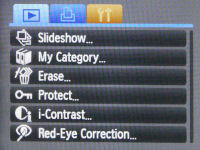

The Canon PowerShot SD780 IS Digital ELPH shares the same playback mode as some other Digital ELPH cameras. You can view your photos (complete with transition effects as you browse through them) and play videos with sound. Functions like print marking, slideshows, voice clip attachment, image resizing, trimming and rotation are all here. You can magnify still photos by 10X and pan around using the navigation pad.
You can view the pictures you’ve taken as individual photos, in sets of nine thumbnails, by category, date, folder or file type (movies or photos). The category function allows you to tag and organize photos into categories as well, in case the camera hasn’t done it for you already.
Image Inspection mode is activated when you press the DISPlay button; which magnifies the focus point(s) in your photos so you can check if the picture is in focus. You can also apply My Colors (photo effects) and iContrast to photos as well as manually remove red-eye via the red-eye removal tool in playback.
The Canon PowerShot SD780 IS Digital ELPH is one of the few Canon cameras to have a lot of image deletion options instead of just the regular “delete one†or “delete all†options. You can delete single images or select multiple pictures by date, category or folder for deletion as well. As for movies, you are able to “trim†sections of a movie clip or delete the whole movie clip all together.
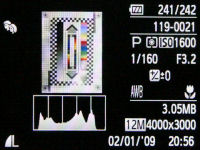
By default, the Canon PowerShot SD780 IS Digital ELPH tells you only the basics about your photos but you can bring up shooting details, mode, exposure information (with shutter speed and aperture value) and a histogram. There’s also an overexposure alert feature which “blinks†overexposed areas of your photos to warn you about them.
Conclusion
The Canon PowerShot SD780 IS Digital ELPH aka Digital IXUS 100 is a stylish, small digital camera that has high-resolution, a HD movie mode and optical viewfinder. As you can probably tell, the SD780 won’t have any problems fitting into even the smallest of pockets, purses or bag compartments. It’s well-built and easy to hold and operate for most part, except the really tiny mode switch on the back. Perhaps women with long fingernails will have an easier time operating the mode switch…
Besides long exposure and manual white balance, the Canon PowerShot SD780 Digital ELPH is mainly a point-and-shoot camera and I wish it had manual controls. The camera features a new 3X optical zoom lens which goes slightly wider than the typical 33 mm of Digital ELPHs AND it has less distortion too. Unfortunately that comes at a price of a slower aperture range (at telephoto, it’s almost 2/3s of a stop slower than the old lens).
Then there are the latest bells-and-whistles, things like face detection, blink detection, Servo AF and face self-timer. The SD780 Digital ELPH even has a Smart Auto mode, which automatically selects a scene mode that matches shooting conditions and the occasion, and as mentioned, a HD movie mode which records 720p videos at 30 FPS with sound.
Other than that, the Canon SD780 Digital ELPH is a fast performer with good focusing and shot-to-shot speeds; it’ll never keep you waiting if you use a fast memory card. The only area where the SD780 didn’t impress was in terms of continuous shooting - it isn’t only this camera; like other 12 megapixel compacts I’ve reviewed, the SD780’s high resolution and large file sizes tend to compromise its continuous shooting frame rates. It’s not like the additional 2 megapixels over last year’s model makes a big difference in photo details.
The Canon PowerShot SD780 Digital ELPH produces good image quality below ISO 800, with nicely saturated colors, low color fringing and distortion and no redeye (thanks to the redeye removal tool available in both shooting and playback modes). If you don’t mind making small 4 x 6 prints, then you could use the camera’s ISO 3200 mode, which lowers resolution to 2 MP but quality is comparable to native 2 megapixel cameras several years back.
If it’s a small and stylish camera with good image quality and performance traits that you want, the Canon PowerShot SD780 IS Digital ELPH aka Digital IXUS 100 fits the bill. The camera is good for for low light stills (party and pub snapshots) and people photos, and with good lighting, HD video.
What’s hot:
- Very good image quality below ISO 800; ISO 3200 usable for tiny 4 x 6 prints
- Compact, stylish design with optical viewfinder
- 3X lens is slightly wider than old lens; less distortion and fringing too (though see below)
- Fast camera performance (Except continuous shooting)
- Smart Auto and a decent selection of scene modes
- 720p HD movie mode with sound; HDMI output for your movies
- Good for people photos: face & blink detection, face self-timer, effective red-eye removal tool
What’s not:
- Lacks manual controls and a live histogram
- Slow zoom lens (worse aperture range than old lens)
- Paltry continuous shooting frame rate (typical for a 12 MP camera)
- Tiny mode switch; flimsy memory card/battery door
Recommended Accessories:
2 GB or 4 GB high-speed SD/SDHC memory card


Hi!
I’m trying to decide between Canon’s Powershot SD780 and SD880. I’m torn between the 12 megapixel resolution and high definition movie mode on the SD780 and the wider angle lens and faster aperture of the SD880. Also I’m wondering about the optical viewfinder on the SD780 since its battery life isn’t spectacular. It looks so tiny, does it actually give a reasonably accurate frame of the shot? Finally which camera would you say produced the better picture? I’ve seen other reviews that slammed the SD780 for really poor detail and high noise (Imaging Resource)
I love your site, it’s wonderfully informative and a huge help in picking a camera! Thank you!
Hi Rachel, using the optical viewfinder on the SD780 will indeed boost battery life numbers. However, it isn’t big (I’m estimating it covers around 70-75% of the actual frame versus 100% coverage on the LCD) which means you’ll get to see the frame’s center, but the actual photo taken will include quite a bit more area around the edges.
Accuracy? Yes, the viewfinder is accurate for just about everything (the crosshairs inside indicate the center of the frame) except close-up shots. But coverage? No, the viewfinder doesn’t cover the entire frame, so you might not be able to see if anything unwanted comes into the actual picture’s edges.
To answer your main question, I would say that a wide-angle lens certainly comes in handy in a lot of situations - group photos, landscapes, indoor shots, etc and 10 vs 12 megapixels of resolution isn’t a huge difference, not enough to be a deal-breaker (in my opinion). 10 megapixels is already more than enough for large prints at home, unless you’re planning to make billboards.
In most cases, the PowerShot SD880 is certainly the more versatile camera, between the mentioned two - bigger screen, 50% better battery life using the LCD, wide-angle lens, sufficient resolution with a slightly faster burst speed…
If you’ve previously owned another digital camera, think of the number of video clips you’ve recorded in the previous 6 months, and how many times you’ve ‘wished’ you could have recorded video at higher resolutions? That could help decide whether you really need the SD780’s HD movie mode, depending on how often you’re going to record movies.
I recently bought my first digital camera, and after narrowing the field down by talking to friends and reading other reviews i thought i would prbably get a low-end Canon point-and-shoot. Based upon your review of the Canon Powershot A480, i went and bught that, and have been VERY happy with it; your review was dead-on, i felt like i already “knew” the camera right after i bought it, and the pros/cons you mentioned matched my experience exactly.
Now that i have been using the A480 “starter” camera, i am seriously thinking of upgrading to both Image-Stabilzation and also better Low-Light handling (“Pub shots” as you call them, and nightclubs, people and bands).
This SD780 is looking like a perfect upgrade, especially since i still tend to mostly just point-and-shoot, not really wanting to fiddle much with most manual controls.
But i am curious, what is the difference between ISO “Auto” and ISO “Auto high”?
thanx! -roseman
Hi Roseman,
I’m glad my Canon A480 review was useful to you =).
Some Canon cameras have two auto ISO modes, as you mentioned.
-Auto is when the camera will select a value between 80/100 to 200/400 for minimal noise in photos
-Auto High is kind of like a high sensitivity mode and the camera will automatically push ISO up to 800, if need be (depends on lighting and surrounding conditions). This is done in order to increase shutter speed, hence reducing the chances of a ‘blurry shot’ being taken. However, do expect additional noise in photos.
You can also set ISO yourself in ‘P’ mode (Program). ISO 80/100 for bright light/outdoors/when the camera is on a tripod, ISO 200-400 in dim conditions (ie indoors, evening shots) and ISO 800 for shots in lower light (such as nightclubs, event halls and such).
Hope this helps,
Brad
After using your review of the Canon Powershot A480 as a deciding factor in purchasing the A480 as a “starter” camera, when it later came time to upgrade (for better low-light handling plus for image stabilization) i decided to rely on your reviews once again, and bought this “SD780 IS”. I am very glad that i did.
This SD780 you are reviewing looked like it would meet my upgrade needs just right, and after using for a few weeks i once again agree with your reviews.
I did have two comments about the “microphone”…
1) You mention correctly in the article that the microphone is located at that little hole in the front. But then later you say one of the three things on top is the microphone… Actually, those little holes on top are for the “Speaker” (not for the microphone) for beeps and the like generated by the camera as well as for listening to video playback.
2) This microphone does WONDERFUL compared to the one in the Powershot A480!!
The microphone in the A480 seems to be designed for BBQs and birthday parties, NOT for full-on Metal concerts at point-blank range in front of the speakers (*duh*). It would distort the sound badly if very loud at all. This SD780 you are reviewing here actually adapts to very loud sounds (rapidly, i might add) so that you can record even loud bands at close range. The audio may be a bit weak on the bass, but at least it is not distorted.
The last upgrade i am contemplating will be the SD980 (similar to SD780 except for a much wider wide-angle, 24mm instead of 33mm; plus a 5x optical zoom). A wider angle is all that i feel like i am missing on the SD780, so i can hardly wait for your review of THAT camera (SD980) later on!
I just hope they keep the better audio recording from the SD780 when they release the SD980.
THANK YOU once again for reviews that are so helpful -roseman
-roseman
Hi Roseman, you're welcome =); glad to hear that my reviews helped you again and that you're enjoying your new Canon SD780.
Yes, indeed the three holes at the top of the camera are for the camera's speaker, not the microphone… sorry about the little mistake there, I must have dozed off while writing the review and mentioned the microphone twice.
Lucky for you, the Canon SD980 is one of the top cameras on my 'to-review' list at the moment. It's Canon's first touchscreen camera and I make it a practice to review cameras that people (such as yourself) would like to see. Look out for the review of that camera soon (towards late September or October I expect, though if you want, I will keep you informed of the exact day when my review comes out)
Yes please, let me know when the review comes out(!)
Actually i am now far more interested in the upcoming SX210-IS model(!)
The SX210 actually has physical controls again just like the sd780 (but unlike the sd980 which *ONLY* had touchscreen). The SX210 also removes a stupid restriction placed on the sd980 where the video mode forcibly cut off at 10 minutes; the SX210 is more like the SD780 in that it can use the full 4GB of video before stopping so you can record video fro 20+ minutes at a time without stopping even in HD.
*Please* let me know when you review the SX210-IS -roseman
-roseman
I just purchased a SD780. Everything seems to work fine except I cannot get sound from a movie. I can hear it just faintly on a camera playback and not at all on a computer playback. Do you know if there is a way to turn the microphone on or off or do I have a problem. I tried it at all movie record settings and nothing. Thanks.
Hi David, your camera might be having a bit of an issue there, seeing that sound is -always- recorded with movies and there is no way to turn sound recording off on the SD780. You should check with Canon’s support or the place where you bought the camera from to get it fixed/replaced.
I have this camera, and its amazing. But, i cant hear the sound when i upload them to my computer. I have windows vista. Its not working. I really dont know what to try because im not really into electronics. Im the type of person who likes to just do it not figure it out. This is really beyond me. i would really love help. Thank you.
The camera store a Quicktime “.MOV” format (with h.264 codec), so the audio should be there. You would need some sort of Quicktime viewer (either the one from apple or a quicktime alternative) to be able to see it at all. The player *should* also play the audio (unless the mute button in the player or the player’s volume control is all the way down). It can be hard to sort all this out without knowing the exact operating system and software that your computer has…
i have the same problem!!! can someone help!?
I would recommend downloading either Quicktime Viewer from Apple or VLC player from videolan.org (it’s free) and trying to play your videos there. I’m using both Windows Vista and Windows 7 machines and I have no problems playing videos with sound from cameras using VLC.
what info do you need from my computer so that we can fix the problem?
Hi. I have this camera. I love it. Recently I can’t get the playback mode button to work. It’s not giving me a preview of all the pics stored. I don’t know what to do. Is this something that needs to be fixed by a professional or am I doing something wrong? If I hold it down long enough, it turns off so it seems to be working for that function at least. Thank for any help you may provide. Your review on this is awesome.
You might want to check with Canon’s support for that. Seems like an in-camera issue
Hi
I’ve the same problem sudenly - did you succeeded to resolve it?
I purchased this very camera last May exclusivley to accommodate my picture-taking of my new grandbaby~before this I’ve never owned a camera other than the drugstore all-in-one single-use type, so I am still a novice at all of this, but want to say how very informative your review has been to me. I have misplaced my owner’s manual somewhere between here and Cincinnati, so I have yet to master all of the features you address as well as putting any pictures on the computer, but there’s plenty of time for all of this~anyway THANKS AGAIN for your helpful information.
Thanks for your reviews, Brad. I’ve narrowed down my choices to the Canon SD 940IS and the SD780. One thing I’ve read frequently is that the manual viewfinder is a huge plus when the LCD screen is nearly invisible due to glare, etc. Also, I definitely need quick continuous shooting capability and there’s mixed reviews for both. Out of the two, which do you think is the better buy?
P.S.
Or is the SC1300 IS better than either?
You write the following: Canon PowerShot SD780 IS Digital ELPH in the US while in places around the world, like Europe and Asia, it’s called the Canon Digital IXUS 100 IS. And in Japan, the same camera sells under the IXY DIGITAL name. Just what IXY model is the same as the reviewed model?
Apologies for the omission, the camera is also known as the Ixy Digital 210S